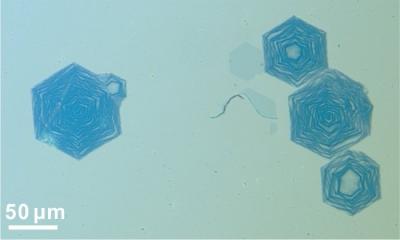Researchers from Rice University managed to synthesize graphene nanoribbons (GNRs) on metal from the bottom up (atom by atom). They call these Graphene onion rings and you can see why from the image below:

The researchers explain that usually, when growing graphene using CVD, the deposition starts as one atom attach it self to a speck of dust or a bump on the metal substrate. The other atoms join in (this is called nucleation) to join the familiar graphene pattern. This time the researchers used a high pressure hyrdogen-rich environment, and this produced the first rings. In this case, the entire edge of the first ring becomes a nucleation site and a new sheet starts under the first graphene sheet.

Graphene grows very fast and this stops the flow of carbon atoms to the bottom sheet, which stops growing and leaves a new (and larger) graphene ring, which becomes a new nucleation site, and the process repeats itself.
This is the first time a GNR is synthesized bottom-up. The usual method is taking a large sheet and cutting it (or unzipping CNTs), but this new method gives better control of the structure and edges. In this particular setup, the rings have zigzag rings which makes them metallic.
The width of those rings changed from 10 to 450 nanometers. They are now attempting to control the width, hoping to be able to consistently make 10-nanometer ribbons - which can be turned into low-voltage transistors or Li-Ion battery cathode materials.